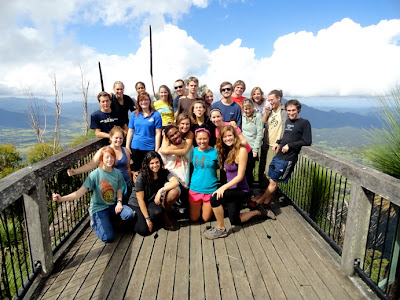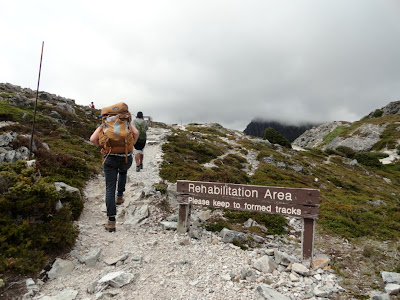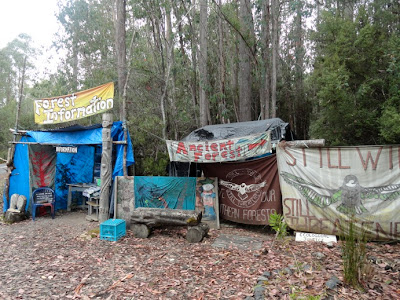I can't believe I've already been living with my homestay family for a week. The time in Lismore is just flying by. So far, we've had a few days of class, two field trips, and couple of days off as well (what a perk!). I can't really say much about my homestay family/the details because of privacy reasons, but I will say that I love them! My family is so sweet - they have the biggest hearts and I really enjoy spending time with them. We've done some cool stuff including going to mass, volunteering at the soup kitchen, and spending an afternoon at the dog beach (where I went for a run and played in the waves). We take turns cooking dinner and the other night, I made butternut squash (known as 'pumpkin' in Australia), sweet potato and carrot soup.




Our first exciting outing was the all day Natural Environment fieldtrip to the Border Ranges National Park. Sometimes I feel like all we do is drive around on this program (it took about 2 hours to get to the park), but once we arrive at our destination, everything becomes clear. The places we see are some of the most extraordinary in the world. We drove by the Nimbin Rocks.
The Nimbin Rocks are made up of Rhyolite and are the product of volcanoes.
We climbed a significant amount of elevation in the bus, as we drove partway up the mountain. While we were closer to the top, we stopped at a picnic area for a lecture and to have lunch. We learned about the climate, geology/geomorphology, vegetation, fauna and human influences of the area. This includes the fact that we could see Mt. Warning from our lookout, which is the best preserved erosion caldera in the world!! SO COOL. (FYI - a caldera is a massive crater that usually forms when a volcano erupts/collapses). So we were essentially looking at the remains of an enormous shield volcano.
View from the picnic area lookout
My friend Katie and I :)
After lunch, we got a chance to take a rainforest hike through Gondwanan, cool temperate rainforests (remnants of Gondwana, the southern super continent once made up of India, South America, Africa, Australia, Antarctica, and present day Arabia). We learned that fire is the main control/determinant in this kind of climate and that the area is extremely high in diversity. The Gondwanan rainforest of Australia is actually a World Heritage area (we've seen a few now) because it shows "major stages of the earth's evolutionary history" and "significant ongoing geological processes, biological evolution and man's interaction with his natural environment" and serves as habitat for "threatened species of plants and animals of outstanding universal value." Very cool. Earlier in the week, some of us even got the chance to visit Terania Creek near our homestays, which is the site of the first direction action taken to protect rainforests..in the world!! (and a success).

Hiking through Gondwanan Rainforest
Walking out to one of the lookouts
Views from the top
Group photo :)
Our next awesome fieldtrip was to OrganicForrest, an organic farm outside of Nimbin run by farmer Dave Forrest (clever name, eh?). He talked with us about food systems, the local and organic food movements, building soil fertility, composting, integrating animals into farming, managing pests and all things that make me happy. He gave us a tour of his farm including the orchards.
CUTEST DOG EVER. Quite a lap dog too.
Palm trees on a farm...I could get used to this
After the organic farm, we made our way over to the Djanbung Gardens in Nimbin. They are based in permaculture principles, which include:
1. Observe and interact
2. Catch and store energy
3. Obtain a yield
4. Apply self-regulation and accept feedback
5. Use and value renewable resources and services
6. Produce no waste
7. Design from patterns to details
8. Integrate rather than segregate
9. Use small and slow solutions
10. Use and value diversity
11. Use edges and value the marginal
12. Creatively use and respond to change
Basically, permaculture is a fusion of many different disciplines including ecology, engineering/planning, geography, and traditional indigenous wisdom among many fields. It also aims to design gardens/food production systems that are modeled after the natural environment (E.g. using biomimcry to create food forests).
The nursery
Really cool bamboo - this variety is one that's mainly used for furniture because it's so decorative in color. The gardens grow a ton of different types of bamboo, much of it used for structural purposes.
Kookaburra in a tree!
"Singing and dancing with abandon is encouraged in this area..." one of the signs posted near the garden
One of my classmates with a piggy!
Seeing citrus grow is amazing. I think these are oranges actually.
The readings we did in preparation for this day of fieldtrips (including "The benefits of organic farming," "Do food miles matter?" "Getting fossil fuels off the plate," "Growing community food systems," and "Following the food chain back to Iraq") in addition to the actual visits were some of the best parts of the program for me so far. These are issues that I care so deeply about and the area in which I want to study in grad school/pursue a future career. So cool beans.
When I was going to sleep last night, I found a creature in my suitcase. Ohh...it's just my homestay kitty Schedrick (aka Scheddy). In fact, he looks a bit like Oliver (one of my cats at home).
Today was also a super fun day. One of my friends and her homestay mom picked me up in the morning around 10 AM and we got a chance to go to the Channon Craft Market, which is held on the second Sunday of each month. According to the website, "The market assembles over 250 stallholders to trade each month in a wide variety of goods which include art, craft, second hand, children’s activities, fresh produce and therapeutic goods and services. There are alfresco dining areas, food and coffee stalls and live entertainment provided by buskers and commissioned musicians. The Channon Craft Market’s reputation, not only as the longest running in the region, but as the most colourful and vibrant market in Australia really is cause for celebration." It was such a cool experience - there were vendors selling everything, with a lot of the products being local, handmade, organic, second hand etc. Needless to say, I spent way too much money. I bought my homestay family some tea (Rooibos Chai - delicious!) and some peanut lime chili spread; I bought myself two headbands, a turquoise stone necklace, and a handmade Byron Bay magnet. I have a weird obsession with magnets actually; I love buying them from places that I've traveled (my fridge at school is usually adorned with my magnets from Santorini and Rome to name a few). I loved the Channon Market not only for all the goodies I could buy, but also for the sense of community, activism, and sincerity.




There was a big anti-nuclear campaign going on (I am not sure if this happens all the time, but I think so). The guy pictured below was walking around in this really intense outfit in protest of nuclear. He was dressed in all black and on his head is what looks like a gas mask.
"Hiroshima Never Again"
"No more nukes. Nuclear power industry is costly. Contaminating the Earth"
We also stayed for the Drum Circle. This was particularly awesome. At one point, I joined in and it was such a fun and liberating experience.
The guy climbed on top of the barrels in protest. A fitting end to the day.





















































































































































